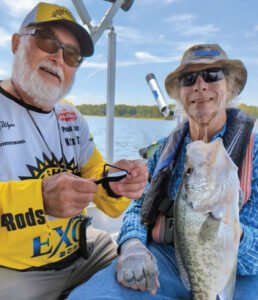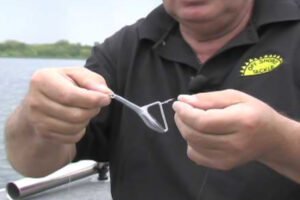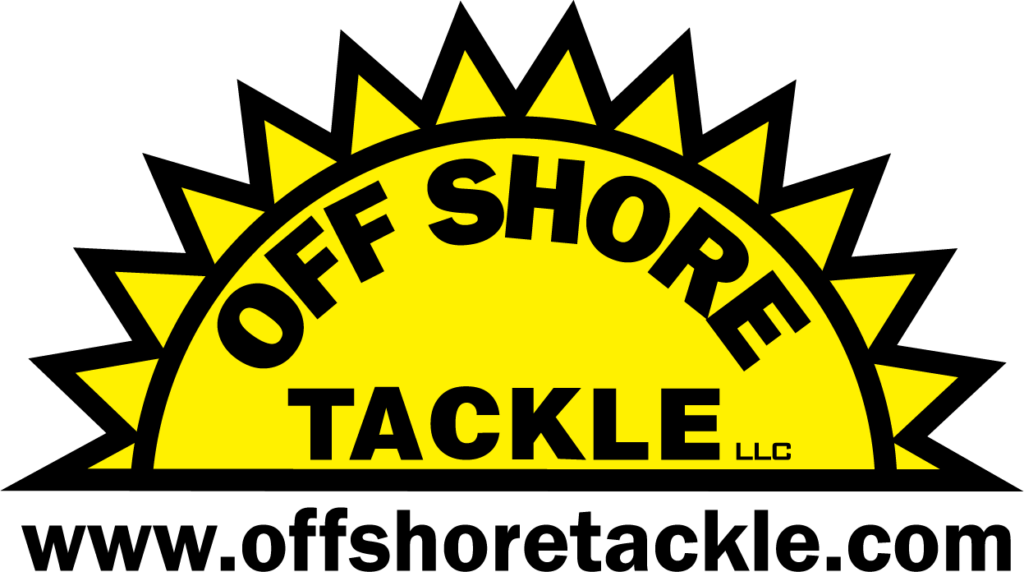Dropper Rod Technique
BY DOUG WYNN
Tom Lipe and I saw the rod dip toward the Grenada Lake surface at the same time. Tom grabbed the rod while I grabbed the net. With only 18 feet of line out, the huge white crappie surfaced instantly. It trailed my Off Shore Tackle OR36 3 Tadpole and white square bill crank. With one motion, Tom and I executed a perfect netting of this fish that appeared to weigh at least 3 pounds. The only problem was I had failed to tighten the extension net handle down and as fast as the monster hit the inside of the net, it was gone! Tom and I stood there in disbelief, looking at my crank hanging in the net where the crappie had just been. What just happened?
What happened was I had just allowed what would have been the big fish of the tournament we were fishing to escape. That cost us several hundreds of dollars. The tackle performed perfectly as designed. The net performed perfectly had I done my job and checked it before we put our baits in the water. I preach having your tackle and gear inspected and ready before the baits are dropped. That June morning, I didn’t.

Being a guide and tournament crappie angler, I’m always looking for ways to add more baits in the water (where allowed) but keep things orderly. Off Shore Tackle’s OR36 series Tadpole diving weights allow me to do both. Years ago, I started using 5-ounce static weights on a rig I called “Dropper Rod”. Behind the weight I run a 4-to-5-foot leader made of slightly lighter test than my main line, then a shallow running crankbait. My Dropper Rods are placed along the gunnel, forward of my rear rod rack for trolling. Five ounces of weight seems overkill, but I needed a way to keep my dropper baits under the boat and out of the way of my longline cranks or jigs. I started using heavy action 6-foot baitcasting rods but have moved onto 10-foot rods that I made by taking 2 feet of tip off of 12-foot crappie trolling rods and adding a catfish rod tip. While the rig looks unconventional, it is extremely effective on big crappie since the dropper baits are the first bait the crappie is likely to see.
When I was invited to become part of the Off Shore Tackle Pro Staff, the static weights of yesterday were replaced by Tadpole Diving Weights. I use Tadpoles behind planer boards, on rods I want to keep away from other lines, and my most productive use, on the Dropper Rods. I fish out of an Excel Storm Cat 230 and can comfortably seat 4 clients while trolling. Having two clients on the bow means I must come up with a way to keep those 4 lines away from the 6 or more lines off the trolling rack. By using the Precision Trolling Data app and the Off Shore Tadpole dive charts, I know how deep my baits will run with a given length of 12-pound fluorocarbon line out. I can use much less line and still keep my baits in the strike zone and not tangling other lines.
I really don’t remember how I came up with the idea of the Dropper Rods. Having pulled crankbaits for all sorts of Kentucky and Barkley Lakes fish for a couple of generations, my equipment has changed but the effectiveness of the tactic has not. Heavy weight allows me to use very short line lengths and put my baits right in the fish’s face. The Tadpole Diving Weights allow me to use much less weight with similar results. Once the strike occurs, the Tadpole trips and the felt weight being reeled up is much less.
I have installed extra bases on my deck for my single rod holders allowing me to be able to move the rod holders around according to how my boat is loaded. My wife prefers to have the rear chairs removed so she can put her rocking camp chair right in the middle which allows her to have equal distance to all the rods. I may be the Captain of my boat but when she is aboard, she is the Admiral. By watching my side scan and down image constantly while trolling, I can see exactly what depth the fish are suspending. Big crappie will suspend most of the time during their migration from deep wintertime areas toward the much shallower spawning grounds. Staying toward the warmer surface temperature water, the next generation of crappie develop faster, allowing them to take advantage of warming spawning areas. Once the spawning occurs, many of the big crappie will stay very shallow in the water column, soaking up the warming temperature water. That way I catch the crappie going both to and from the spawning grounds.
Last spring, I kept seeing scattered individual fish, suspended as shallow as 4 feet above as deep as 30 feet of water. Out of curiosity, I started using the Dropper Rods much earlier than I normally would have. Some days I would have less than 10 feet of line between the rod tip and the #3 sized Tadpole. The results were amazing. I probably had over 20 clients who caught their all-time personal best crappie while fishing with me. A large percentage fell to the Dropper Rod technique. That information was kept between me and my clients. I had many folks’ text or call me asking how I was catching such big crappie in the same areas they were fishing but catching few to none. Sometimes your cards have to stay near your vest.
By using the Dropper Rod technique, you will improve your crappie catch and take advantage of those suspended fish you never paid any attention to. While you won’t feel the “thump” of a strike or get to fight the fish for a bit, you will improve your catch and, in the end, that’s what it’s all about.
Note: Captain Doug Wynn can be reached at Crappie-gills-n-more.com.



